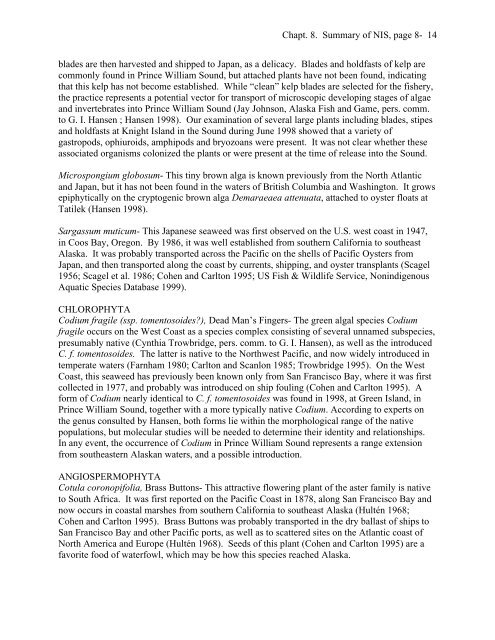Biological Invasions of Cold-Water Coastal Ecosystems - Aquatic ...
Biological Invasions of Cold-Water Coastal Ecosystems - Aquatic ...
Biological Invasions of Cold-Water Coastal Ecosystems - Aquatic ...
Create successful ePaper yourself
Turn your PDF publications into a flip-book with our unique Google optimized e-Paper software.
Chapt. 8. Summary <strong>of</strong> NIS, page 8- 14<br />
blades are then harvested and shipped to Japan, as a delicacy. Blades and holdfasts <strong>of</strong> kelp are<br />
commonly found in Prince William Sound, but attached plants have not been found, indicating<br />
that this kelp has not become established. While “clean” kelp blades are selected for the fishery,<br />
the practice represents a potential vector for transport <strong>of</strong> microscopic developing stages <strong>of</strong> algae<br />
and invertebrates into Prince William Sound (Jay Johnson, Alaska Fish and Game, pers. comm.<br />
to G. I. Hansen ; Hansen 1998). Our examination <strong>of</strong> several large plants including blades, stipes<br />
and holdfasts at Knight Island in the Sound during June 1998 showed that a variety <strong>of</strong><br />
gastropods, ophiuroids, amphipods and bryozoans were present. It was not clear whether these<br />
associated organisms colonized the plants or were present at the time <strong>of</strong> release into the Sound.<br />
Microspongium globosum- This tiny brown alga is known previously from the North Atlantic<br />
and Japan, but it has not been found in the waters <strong>of</strong> British Columbia and Washington. It grows<br />
epiphytically on the cryptogenic brown alga Demaraeaea attenuata, attached to oyster floats at<br />
Tatilek (Hansen 1998).<br />
Sargassum muticum- This Japanese seaweed was first observed on the U.S. west coast in 1947,<br />
in Coos Bay, Oregon. By 1986, it was well established from southern California to southeast<br />
Alaska. It was probably transported across the Pacific on the shells <strong>of</strong> Pacific Oysters from<br />
Japan, and then transported along the coast by currents, shipping, and oyster transplants (Scagel<br />
1956; Scagel et al. 1986; Cohen and Carlton 1995; US Fish & Wildlife Service, Nonindigenous<br />
<strong>Aquatic</strong> Species Database 1999).<br />
CHLOROPHYTA<br />
Codium fragile (ssp. tomentosoides), Dead Man’s Fingers- The green algal species Codium<br />
fragile occurs on the West Coast as a species complex consisting <strong>of</strong> several unnamed subspecies,<br />
presumably native (Cynthia Trowbridge, pers. comm. to G. I. Hansen), as well as the introduced<br />
C. f. tomentosoides. The latter is native to the Northwest Pacific, and now widely introduced in<br />
temperate waters (Farnham 1980; Carlton and Scanlon 1985; Trowbridge 1995). On the West<br />
Coast, this seaweed has previously been known only from San Francisco Bay, where it was first<br />
collected in 1977, and probably was introduced on ship fouling (Cohen and Carlton 1995). A<br />
form <strong>of</strong> Codium nearly identical to C. f. tomentosoides was found in 1998, at Green Island, in<br />
Prince William Sound, together with a more typically native Codium. According to experts on<br />
the genus consulted by Hansen, both forms lie within the morphological range <strong>of</strong> the native<br />
populations, but molecular studies will be needed to determine their identity and relationships.<br />
In any event, the occurrence <strong>of</strong> Codium in Prince William Sound represents a range extension<br />
from southeastern Alaskan waters, and a possible introduction.<br />
ANGIOSPERMOPHYTA<br />
Cotula coronopifolia, Brass Buttons- This attractive flowering plant <strong>of</strong> the aster family is native<br />
to South Africa. It was first reported on the Pacific Coast in 1878, along San Francisco Bay and<br />
now occurs in coastal marshes from southern California to southeast Alaska (Hultén 1968;<br />
Cohen and Carlton 1995). Brass Buttons was probably transported in the dry ballast <strong>of</strong> ships to<br />
San Francisco Bay and other Pacific ports, as well as to scattered sites on the Atlantic coast <strong>of</strong><br />
North America and Europe (Hultén 1968). Seeds <strong>of</strong> this plant (Cohen and Carlton 1995) are a<br />
favorite food <strong>of</strong> waterfowl, which may be how this species reached Alaska.














